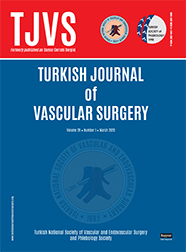
The Turkish Journal of Vascular Surgery
Yazarlar: Vedat YILDIRIM, Suat DOĞANCI, Ömer YANARATEŞ, Cengiz BOLCAL, Ufuk DEMİRKILIÇ, Ahmet ÇOŞAR
Konular:-
Anahtar Kelimeler:Brachial plexus; arteriovenous fistula; vascular patency
Özet: Objective: Long term patency of arteriovenous fistula is relevant to management of end stage renal failure patient on hemodialysis. Increased sympathetic activity and spasm of radial artery during the surgery may responsible for early occlusion rate. Aim of the study is to investigate the efficacy and the role of preemptive infraclavicular brachial plexus block on prevention of the radial artery spasm and fistula patency. Material and Methods: Forty patients were randomized into two groups. Infraclavicular brachial plexus block was performed in Group 1. Another group was considered as a control group (Group 2). In this group AVFs were performed under local anesthesia without infraclavicular blockage. Radial artery diameter (in group 1: before and after infraclavicular blockage, in group 2: only before procedure), fistula blood inflow rate and blood flow velocity were calculated. All AVFs were constructed on the forearm using autologous veins. Results: Average fistula blood inflow rate was 214.2±29.4 ml/min in Group 1 and 153.4±26.3 ml/min in Group 2 (p<0.001). While average blood flow velocity of radial artery was 172.1±27.3 cm/sec in Group 1, it was 103.3±12.4 cm/sec in Group 2 (p<0.001). Average radial artery diameter in group 1 2.4±0.4 mm and 2.5±0.3 mm in group 2 (p>0.05). Average radial artery diameter after the completion of infraclavicular blockage 2.9±0.3 (p<0.01). Thrill was found in all Group 1 patients, but there was thrill only 11 of the Group 2 patients (p<0.001). Mean maturation time was 39.4±6.1 days after surgery in Group 1 and 70.2±9.1 days in Group 2 (p<0.001). Adequate vascular access was obtained 17 patients in Group 1 and 10 patients in Group 2 (p=0.042). Conclusion: AVF occlusion rate is much more common in early postoperative period. Diminished sympathetic tonus by preemptive infraclavicular brachial plexus block not only increases early patency rate but also increases fistula maturation rate.